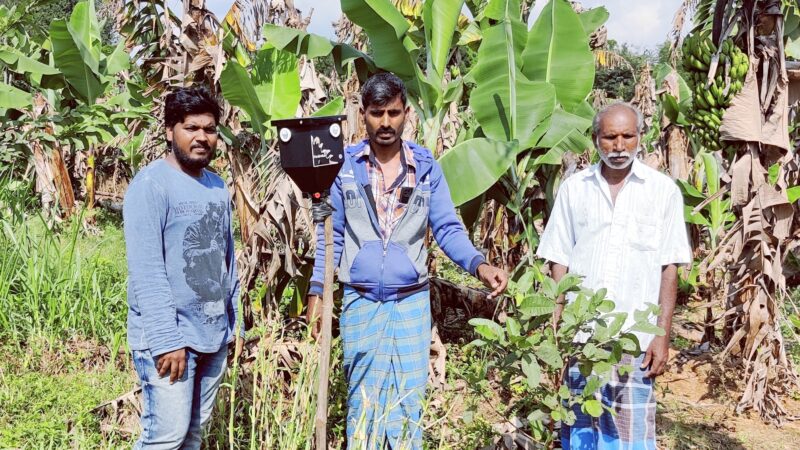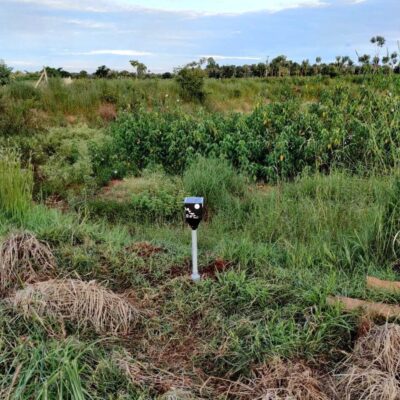The device keeps away wild animals and reduces crop loss
Originally published on Global Voices

A farmer’s family in V-Kota village of Andhra Pradesh with an installed Parabraksh in their field. Image credit: Katidhan. Used with permission.
Forty-year-old Malan Raut from India’s western state of Maharashtra was a contented farmer when she switched to organic farming in 2016 to weather the impact of climate change. She grows cereals, pulses and vegetables on 3.5 acres of land in her native Nagarsoga village. But, three years later, she encountered an unexpected problem — she was losing crops to wildlife attacks.

Malan Raut next to the Parabraksh installed in her field in Nagarsoga village of Maharashtra. Image credit: Katidhan. Used with permission.
“Herds of wild boar and deer would storm into my land at night from a nearby patch of wilderness and trees — eating away, trampling upon and destroying my crops,” Malan told Global Voices in a phone interview. According to her, it caused annual losses gradually increasing to about INR 30,000–40,000 (USD 376–500), and becoming difficult for her family to bear.
In 2020, a local non-profit called Swayam Shikshyam Prayog in Latur made her install a device called Parabraksh (which in Kannada, the language of the southern state of Karnataka, means protection from wild animals).
Parabraksh uses solar-powered technology to generate light flashes to scare animals away from agricultural fields, without harming them. It comes with a 6-watt solar panel fitted to a lithium-ion battery and 4 LED lights that blink away all night creating random patterns across the field. The lights are visible from a distance of 300–500 metres (depending on the landscape) to deter the animal from intruding into the targeted area.
Malan installed it at the vulnerable entry point of her farmland. Today she is much relieved. “The animals do not come anymore in my field, it is almost 97–98 percent effective,” she said.
The device costs INR 10,000 (USD 125) and is manufactured by Bengaluru-based research and scientific innovation organisation Katidhan, in Karnataka. According to SR Ayan, who heads the organisation, the programmed flashing patterns the device emits attack the cognitive vision of animals such as wild boar, nilgai, bison, elephants, tigers, and leopards thus holding them back from entering the targeted areas.

Long shot of the animal deterrent light amidst an agricultural field in Tamil Nadu. Image credit: Katidhan. Used with permission.
“Forests, or the natural home of wildlife are getting fragmented, destroyed and disturbed, due to expanding human habitations and developmental activities,” said Sanjeev Kumar, Additional Principal Chief Conservator of Forests, Jharkhand to Global Voices over email. He said this is what compels animals to enter villages (especially those bordering the forests) in search of food and water, which invariably leads to crop raids, livestock killing etc., causing human-wildlife conflicts.
Although countrywide collated data on crop losses are not available, the severity of the incident can be gauged from certain government figures — according to which India’s southern state of Andhra Pradesh alone has suffered crop losses over 5543 acres of land in 7589 incidents between 2017 and 2020. Tamil Nadu also reported a total of 7,562 incidents of crop-raiding by wild animals during the same period.
According to Ayan, this animal deterrent solar light has so far reached out to more than 1000 farmers across 100 villages in 12 states besides certain coffee, banana plantation owners, 3 or 4 state forest departments and various wildlife and developmental organisations.

Parabraksh being installed outside a cattle enclosure in a village in Ladakh. Image credit: Snow Leopard Conservancy India Trust. Used with permission.
It was first deployed in 2019, to keep snow leopards from killing livestock in the remote Kesar village of eastern Ladakh. The villagers here are mostly shepherds who rear sheep and mountain goats on the sloping Himalayan pastures.
According to Jigmet Dadul, from the Snow Leopard Conservancy India Trust, who coordinated the installation process on behalf of the villagers, they kept nearly 150–200 head of cattle collectively in community enclosures for grazing in summer pastures. These corrals had no roofs or doors and the predator got in at night easily, preying on one, but killing or injuring nearly 50 percent of others in the attack, and abandoning them in the enclosure itself. This caused a loss of about INR 200,000 (USD 2,509).
Ten Parabraksh units were installed outside the community enclosures in seven villages. The Snow Leopard Conservancy India Trust also helped villagers to build roofs and doors on the enclosures, to protect their cattle from further attacks.

Prabraksh installed in Vikram Munda’s field in Bandhuabeda village of Odisha stands tall to keep out elephants. Image credit: Katidhan. Used with permission.
Vikram Munda from Bandhuabeda village in India’s eastern state of Odisha, who cultivates cashew nuts, paddy and local seasonal vegetables, lamented annual losses worth about INR 60,000 (USD 753) caused by herds of wild elephants. Parabraksh, however, came to his rescue, in 2020.
“Earlier we had to stay up all night before harvest season, bursting crackers, waving burning torchlights to keep away the elephants who came in groups of at least 6–7 each time, from the nearby forests,” he said.
According to Debashish Sharma, Divisional Forest Officer, Purulia (West Bengal), elephants are range animals that move across forests. These villages were once a part of their traditional migratory routes passing through contiguous forests connecting Odisha with its adjoining states. But today they have been reduced to broken, isolated patches, interspersed with these villages — where wild elephants end up straying.

Parabraksh from close quarters guarding chillies in a field in Odisha. Image credit: Katidhan. Used with permission.
“Further, with depleting food in the forest, these wild elephants are found to be changing their dietary preferences — from the earlier cellulose-based forest diet, today it opts for the easily available and more filling starch-rich crops in the fields,” said Sharma. And, being the largest herbivores, with the maximum food intake, the damage they do is much more extensive than other crop-raiding animals, he added.
In Therubeedi village of Karnataka, organic farmer Raghavendra Bhat is troubled by monkeys. ”They come in hundreds screeching and screaming jumping across trees and plundering my crops, besides lifting my hens and chicken,” lamented Bhat. He suffered annual losses worth up to INR 150,000 (USD 1,882) each year, on his 15-acre farm.

Solar powered acoustic device – Kapikaat – installed in one of the trees in Raghavendra Bhat’s farm, in Karnataka keeps away monkeys.Image credit: Katidhan. Used with permission.
However, last year he put up Kapikaat, a solar-powered acoustic device developed by Katidhan to repel his unruly visitors. The device, tied to trees 10–12 feet high, emits varied sounds such as the growls and roars of predators, gunshots or firecrackers to scare them away. However, according to Bhat, it is 60–70 percent effective, as the monkeys have started entering the field from other sides.
For Ayan, it is indeed a challenge to outdo the intelligence of wild animals and keep them at bay. Katidhan, meanwhile, is also trying to find solutions for how farmers can use the same device to keep multiple species of wild animals out of their fields. “We are customising the height adjustment options, during installation of the device, such that its deterrent flashes can precisely hit the eyes of the targeted animals,” he said.
The organisation has a target of reaching out to 2000 more farmers across 150 more villages this year, besides at least 15–20 owners of plantations, including coffee, rubber, tea and coconuts, along with more state forest departments.
Post a Comment